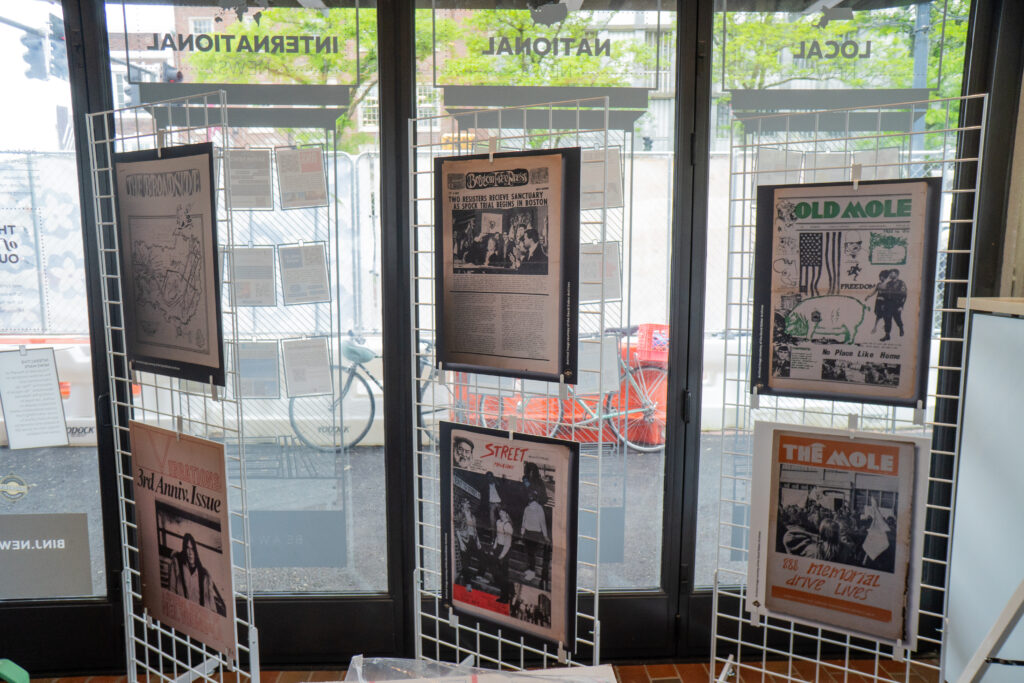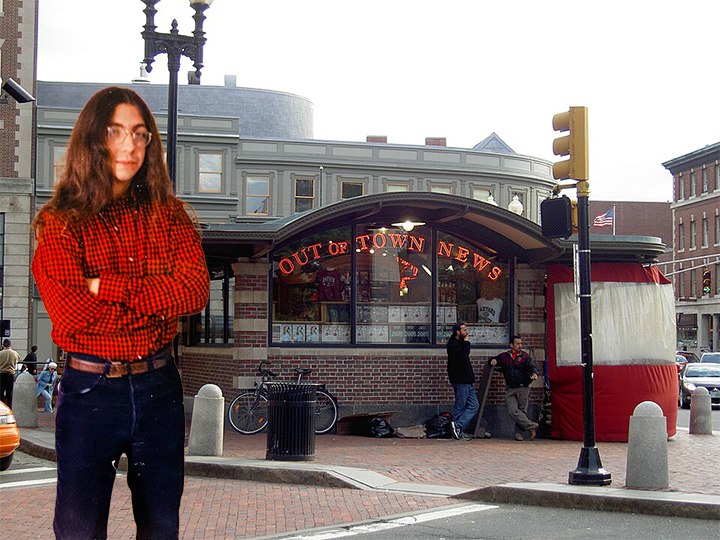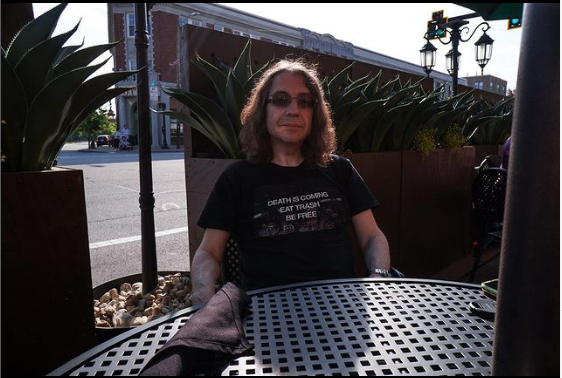My brief and tumultuous tenure working at the famed Harvard Square newsstand was nothing if not formative
When my Boston Institute for Nonprofit Journalism partner Chris Faraone first broached the idea of BINJ working with the folks at CultureHouse and the Cambridge Office of Tourism to put up an exhibit that’s basically about the Cambridge underground press and its successors in the former Out of Town News kiosk—now tastefully refurbished and dubbed Cambridge Kiosk—in the middle of Harvard Square for a month, I immediately said “awesome, go for it.” But inwardly I was filled with a whole range of emotions, pleasant and painful. Because that newsstand played a key role at several points in my life in a variety of related ways. And I thought I should say a few words about it before BINJ’s initial run (and roster of interesting talks) in that old and yet new space ends next week.
I am a product of the Cambridge underground press. Just after I turned 20 years old, I got involved with Street Magazine—which, contrary to what you see on sites like Wikipedia, was probably the first publication sold by homeless vendors in the US. By January 1987, I moved into the old three-story brownstone on Essex Street in Central Square that its rotating cast of residents called the Street Magazine Commune. Key Street staff squatted there in a building zoned for commercial use along with basically anyone who needed a place to crash and produced a very interesting and eclectic monthly from offices on the first floor.

Cambridge-based underground newspapers from the 1960s to the 1980s at BINJ’s 2025 Cambridge Kiosk exhibit. Copy of Street Magazine can be seen in the middle of the bottom row. Photo by Jason Pramas. Copyright 2025.
The counterculture that had taken root in Central and Harvard Squares in the 1960s was still barely hanging on in the late 1980s. I was part of it. I also hung out at MIT a lot as someone active in left-wing student protest circles and was present as a new-fangled thing called the Internet was being readied for public consumption. And readers should understand that the Cambridge of 1987 was more high-tech than anywhere else on the planet, but it was another era. The Cold War was still going on. More people were buying personal computers, but only a tiny percentage of the population had the equipment, training, funds, and connections needed to use early versions of email. The prototype of the World Wide Web was still two years away, cell phones were in their infancy, and smartphones were two decades in the future.
So people read print media for news, for education, and for pleasure. They read newspapers, magazines (and indeed zines), pamphlets, and books. There were many places to purchase such printed matter in a college town like Cambridge, including in Central Square. There were bookstores all over the place, making books easy to find. Smoke shops, drugstores, and markets sold the major regional newspapers and national magazines.
But if you wanted to check out the broadest array of newspapers and magazines around, you went to Out of Town News in Harvard Square. I had first gone to its old stand when I was 12 or so and was amazed at the hundreds of different titles on offer from all over the world. But after the Red Line MBTA Northwest Extension project was finished in 1985, Out of Town moved into what had been the old Harvard Square T station entrance building (which became its last kiosk).
And it was then, as I was starting my fateful final year at Boston University prior to being expelled for political activism, that I started really hanging out there and reading stuff without buying it. Which you could do if you were chill and careful with the merchandise. That’s where I went to read international news that went far deeper than what one would get from most mainstream American press outlets. That’s where I was exposed to literary magazines and speciality publications of all kinds.
It was only natural that I should spend my free time in Harvard Square because that was where all the many Cambridge and Boston subcultures and scenes intersected with people drawn from around the globe by Harvard. And MIT, too. Kendall Square hadn’t been fully engulfed by that apex tech college at that point, nor had it really been revived yet (and I would argue that it never really has been as a living breathing public space); so people from the MIT scene I was connected to would go to Harvard Square to hang out like everybody else.
And the beating heart of Harvard Square was Out of Town News. In an age when we didn’t all carry personal communicators with GPS-powered maps on tap, it was the most common place to meet someone before going wherever you were going in the square and the most obvious landmark. And what did you do there while waiting for your people to show up? You browsed the racks of newspapers and magazines. Then, likely as not, you picked up something there you couldn’t find anywhere else.
Sure, competitor Nini’s Corner had its charms, as did the Harvard Coop’s periodicals section, both right across the street. But everyone was buzzing about Out of Town all the time, day or night, like swarms of overeducated bees. The plaza built next to it as part of the new T entrance that went with the Red Line extension to Alewife was all part of the same endless happening. That became known as “the pit.” And I was there so much starting in 1985 that I was one of the early “pit kids”—the wild and ever-shifting bunch of mostly young people that made its red bricks home. Sometimes literally.
Which made it all but inevitable that I, a young street crawler and writer who frequently hung out right nearby, would find myself in need of gainful employment in July 1987 … and managed to get a job selling newspapers and magazines at Out of Town News shortly thereafter.
My big boss was the legendary Sheldon Cohen, but my immediate boss was his brother Fred. I pulled five shifts a week there most weeks and quickly learned the ropes of stocking periodicals, working either of the two main cash registers (inside and outside), and how to get the portable outdoor racks under the awning in bad weather under Fred Cohen’s ever-watchful and sometimes exasperated eye.
I specifically remember him and another old timer showing me how to do my favorite weekly task: putting hundreds of Boston Sunday Globes together late Saturday night when the news and sports sections arrived and we combined them with all the other sections and circulars that were printed earlier. Something about being one of the first people to read the huge doorstop of an edition outside the Globe newsroom and print shop every seven days made me feel special, I guess.
Fred and company didn’t care overmuch how I dressed, as long as I showed up and did my job. So that’s what I did, long hair, shades, ripped jeans, and all. I basically got to talk to all kinds of people all day and really enjoyed that. I memorized all the publications and their prices within a few days and could manually ring everyone up super fast. The Cohens didn’t pay much, but it was something. And a bunch of my pit friends were always around. One particularly friendly friend would come over and make out with me when I worked the outside register, but my bosses never hassled me about her.
So it was basically one of the best gigs I ever had. And I learned a great deal about publishing by reading everything I could lay my hands on while I worked and off-hours as well. Knowledge which served me in good stead going forward.
At the time, Out of Town News also ran two concession stands in the subway station proper: a larger one under the main station entrance and a smaller, coffin-like one near the entrance that snakes under Mass Ave between Church Street and the Harvard main campus near Johnston Gate, both long closed for commercial use. Within a couple of weeks, Fred assigned me to work shifts down there. Both stands were incredibly busy. I didn’t love the little one, but the big one was a blast. The bosses rarely came down there; so I was mostly unsupervised. And while I felt like a Morlock in those catacombs at times, I was in constant motion hawking drinks, snacks, and papers during every wave of T and bus arrivals every few minutes. Chatting with everyone, getting to know regulars by sight. That was super fun.
Unfortunately that period came to an end when I stepped up on a shelf to reach for something on a higher one and it gave way. I smacked my chin on a counter coming down and came to flat on my back with a worried crowd surrounding me as blood dripped from the wound I had just acquired.
As my vision came into focus, I saw that Fred was there, too, asking if I was ok. He put me into a cab to the Mount Auburn Hospital ER where they stitched me up. Workers comp covered the treatment; so that was cool. And Fred was too. Like cool as a cucumber. I had no idea at that time that he had been a Green Beret and paratrooper in the Vietnam War where he won a Bronze Star for bravery. So the sight of blood phased him not at all and he seemed to know exactly what to do when an employee got injured. He kept me at the main kiosk after that, though.
Naturally, there were plenty of fights in Harvard Square; so all of us saw some blood from time to time anyway. Usually not our own. There was always the Bridge Over Troubled Waters medical van, parked on the Dunster Street side of the pit, if anyone needed immediate treatment. My fellow pit kids and I certainly used it. Especially after I became homeless not long after starting the Out of Town job and literally slept there when I couldn’t find anywhere to crash. Turning me from one of many transitory pit kids to a member of the … ah … let’s say “select” group of pit kids that actually lived in and around the pit. An experience I’ve written about before; so I won’t rehash those details here (other than to reiterate that I really did yell “JUMP!” at wealthy people passing by my register late in the afternoon of the Black Monday stock market crash).
If Fred ever noticed that I didn’t really leave the square after work most nights, he never said anything. But he didn’t miss much; so he probably knew I was sleeping out of doors sometimes and couch surfing when possible.
As weeks turned into months, I settled into my job and began to think that I might manage to save a few bucks and get back into a collective house or apartment before winter set in.
And then I did a dumb thing. Throughout this period, I was also a leader of a national movement to restart the 1960s radical organization Students for a Democratic Society in some fashion. While all the above antics were happening, I had been constantly working with those MIT kids I mentioned to pull together a New England organizing conference in November for the National Student Convention ‘88 slated for Rutgers University that coming February.
And while we had dozens of student activists convened to debate how that convention should be run, word came in that some military-industrial complex big was about to give a speech at Harvard’s Kennedy School of Government. We spontaneously decided to march over there and try to give that worthy the bum’s rush.
Now this was late on a Saturday morning. I normally had a shift at Out of Town News on Saturdays, but had been so busy with the conference I hadn’t thought to ask for the day off. So I had ended up hastily calling Fred and telling him I was sick early that same morning.
That fact was nowhere in my mind when I gamely got to the front of a column of activists at lunchtime and marched down Mass Ave from MIT’s Building 7 to Harvard Square, the Kennedy School being three blocks up JFK Street from there.
Meaning we went right by Out of Town News. Which would have been ok, had I not decided to give a speech in front of the Coop before we headed to our action … using a megaphone.
Fred was out in front of the kiosk, probably doing my job in my absence. And the moment I started speaking he locked eyes with me. I finished my snap address and ran across the street to talk to him.
I said “I’m sorry.”
He said, levelly, “You’re fired.”
And that was that. I rejoined the march and we charged into KSG. It’s a bit of a maze in there; so we didn’t find the person we were trying to confront. We got out before the cops came and realized some people were still lost inside the building. And there was some Harvard drama I’ll skip over. But it was a stupid and pointless way to lose a decent job. And my life got a good deal more difficult for the next few months.
There are many other relevant reminiscences I could share, but the most important happened seven years later with the 1994 launch of my small national publication, As We Are: the magazine for working young people. It had been extremely tough getting distributors to work with me, but I did convince a couple of them to get the first issue placed on newsstands nationwide.
So one fine day, I walked into Out of Town News and there was my own magazine, very official looking bar code and all, out on a rack for sale—in among much slicker, more established, and far better-funded periodicals. And I smiled one of the biggest smiles of my life.
I never got a cent from those distributors in the end. But I didn’t care.
Apparent Horizon—an award-winning political column—is syndicated by the MassWire news service of the Boston Institute for Nonprofit Journalism. Copyright 2025 Jason Pramas.






